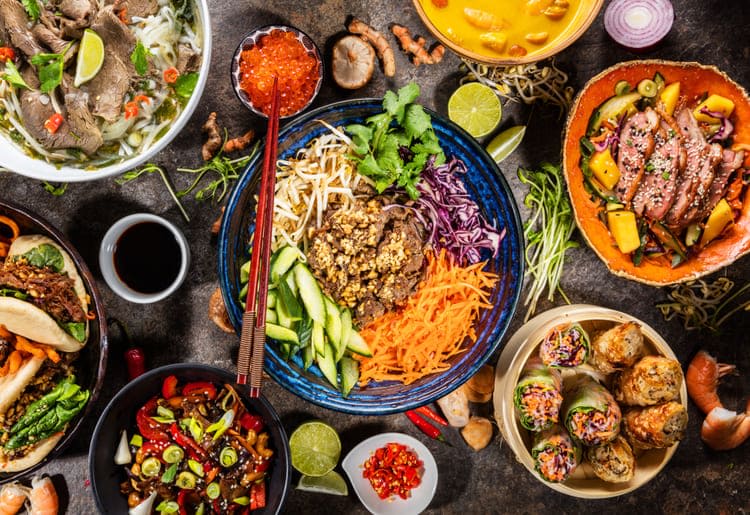Dairy, peanuts, eggs, and soy are some common foods that can trigger allergic reactions in babies. And because many different foods can trigger these reactions, you may need to go on an elimination diet to find out which food is the culprit.
But it's important to get the right support and guidance from your doctor or nutritionist. They need to ensure that your calories don’t dip too low. A severe calorie drop can negatively impact your breast milk supply (1).
You also need to be vigilant of any nutritional deficiencies that can arise from removing foods from your diet. Meal delivery can be a helpful tool in maintaining a healthy dairy-free diet.
Here are 10 tips for moms going dairy-free while breastfeeding.
» Want to add more veggies to your diet? Check out our top picks for the best vegan meal delivery services.
1. Understand What Dairy Actually Is
What exactly is dairy? Are eggs dairy? Can you eat cheese or yogurt? It can get confusing to know how "dairy-free" applies to you.
No, eggs are not dairy. Dairy is an umbrella term for milk and milk products. So technically, breastmilk is also a dairy item.
But our concern is milk from animals such as cows or goats and anything made from milk, such as butter, ghee, cheese, yogurt, whey, cream, ice cream, and casein.
If your baby is lactose intolerant, you can still have milk-based foods that are lactose-free. So, you can have butter, ghee, and yogurt, as these may contain only traces of lactose. With less than 1 gram per serving, cheese is also very low in lactose.
Unless the sensitivity is extreme, these foods are a safe bet. Lactose intolerance arises when we don't produce enough of the enzyme lactase needed for digesting lactose (2).
If your baby is allergic to milk proteins, it is because their immune system overreacts to the casein present in milk. If that’s the case, it's best to avoid milk products altogether.
2. Get Rid of All Dairy Products at Home
Once you decide to go dairy-free, you shouldn't keep any temptations around. Give away all the milk, cheese, and ice cream in your fridge. And get rid of any milk powder.
You also need to know which foods have "hidden milk" in them. Gift away these as well, and make sure they stay off your grocery lists.
It can take up to 3 weeks to remove all traces of dairy from your system. So you need to wait for at least that long before evaluating if going dairy-free has helped your baby.

3. Check Food Labels
So, how do you find foods that contain "hidden milk"? That’s where food labels come in.
By law, products should be clearly labeled with an allergen warning—"Contains Milk"—at the end of the ingredient list (3).
But to be safe, you also need to check for any peculiarly named items, especially in processed foods. Look for any terms that are related to dairy, such as:
- Hydrolysates
- Casein
- Whey
- Koumiss
- Lactalbumin
- Lactoglobulin
- Lactulose
- Artificial butter flavor
- Butter oil
- Custard
As a breastfeeding mom, it's best to avoid chemically processed foods, as these can harm you and your baby. So read the labels on products and don't buy anything that contains ingredients your grandmother wouldn't recognize.
» Make sure to avoid these foods while pregnant.
4. Buy Foods Labeled "Vegan"
The vegan lifestyle has become quite popular, so the market is flooded with vegan-friendly products. This is great news for moms going dairy-free because vegan foods are completely free of milk and milk products.
But, if you decide to follow a purely vegan diet, make sure to incorporate these nutrients vegans may be lacking into your diet.
5. Look Up Restaurant Menus in Advance
Eating out can be a problem when trying to stay on restrictive diets. It's best to check out restaurant menus beforehand for any dairy-free options. Most restaurant menus are available online.
Still, their batter may contain milk, or they may use butter to sauté veggies. It's always better to notify the waiter that you cannot have dairy and request that your meal is prepared accordingly.
6. Try Asian Cuisine Dishes
If you are in the mood for exotic cuisine, try Chinese or Korean dishes. Asian cuisine generally doesn't use much dairy, while continental cuisine uses a lot of milk, butter, cream, and cheese.
But don't take this for granted. A packet of ramen noodles may contain dairy, so don't forget to check the ingredient labels.

7. Find the Best Dairy Substitutes
If you're missing dairy or craving a hot cup of café au lait, we've got you covered. There are plenty of substitutes for every dairy product you can think of.
You can use pureed tofu instead of yogurt. You can even add some lemon to make it tangier. Cashew-based yogurts are also available in most grocery stores—just check out their vegan section.
You can substitute the butter in baking with apple sauce, fruit purees, or oil. And nutritional yeast can give you that cheesy flavor, while mashed avocado can be used to create texture.
» Looking for certified dairy-free meals? Try Freshly.
8. Try Non-Dairy Milk Options
There are many different non-dairy milk options for you to choose from, such as coconut milk, almond milk, soy milk, or oat milk.
Experiment and see what suits your taste buds best. Oat milk has a more neutral flavor suitable for making coffee, while coconut milk has a stronger taste. Try a cold coconut coffee shake or a nutty almond chocolate milk.
These kinds of milk are also a good substitute for cream in baking and cooking.
9. Build a Dairy-Free Meal Plan
Changing your lifestyle to dairy-free is not an easy task. It requires planning and dedication. It's like Benjamin Franklin said, "If you fail to plan, you are planning to fail."
After getting rid of your dairy stock at home, plan your meals and stock up fresh with dairy substitutes.
Meal prep is essential. Having quick meals on standby will prevent cravings and stop you from running to the nearest café for a fresh cup of coffee or a cheesy sandwich. FYI, most bread and buns contain milk.
10. Find Online Support
It's important to know that you are not alone. Many other parents are facing the same issue. But together, we are stronger. Adjusting to life with a new baby is difficult, and we need all the help we can get.
Social media is the quickest way to find support groups online. Check out Facebook and Instagram to find and join such groups. Reach out for support, encouragement, and tips. And offer some advice in return.

Before You Go Dairy-Free...
If you are a dairy lover, then going dairy-free can seem like a daunting task. So it's best to reach out to your child’s pediatrician, a nutritionist, and online support groups for guidance and support.
Omitting dairy from your diet will create new problems you'll need to solve. It's important that you replace this caloric source with suitable foods. And because hydration is essential for nursing moms, you'll also need to drink plenty of liquids that are dairy free.
» Create simple, healthy dinners with Green Chef today.
